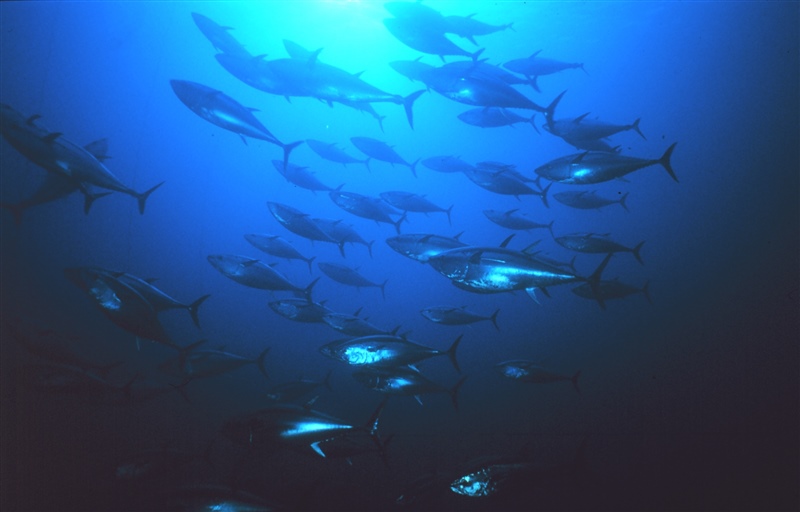Offshore finfish farming (OFF) is the mass cultivation of finfish in marine waters, in underwater or floating net pens, pods, and cages. One of the many perils of eating industrially produced farmed finfish is that we never know the full suite of drugs and chemicals applied in the growing process. For over 20 years, the salmon fish farming industry has taught us the multitude of hazards associated with raising thousands of finfish crammed together in nets or cages. Those same problems will be transferred to offshore fish farms, where they will be out of sight and out of mind.
Aquaculture farming industries routinely use toxic pesticide treatments on farmed fish living in an enclosed marine environment, including emamectin benzoate in fish feed and organophosphates and pyrethroids for fish delousing. Fish lice are the greatest challenge to aquaculture production and environmental sustainability. Resistant lice appear in farm pens in as little as 10 years post-pesticide treatment and easily flow into the open waters through the cages and nets due to their small size. These resistant sea lice outbreaks spread quickly and can cause massive environmental damage if they are not stopped in time.
Oftentimes, the only way to curb an outbreak is to kill off the entire population of fish - wasting not only the fish themselves but all of the resources that went into growing them. For instance, in 2017, over a quarter-million salmon died from sea lice infestations, thus prompting two salmon farms in the Bay of Fundy in New Brunswick, Canada to intentionally kill another 284,000 salmon to curb the outbreak.
In Scotland, the Scottish Environment Protection Agency (SEPA) is taking an antithetical approach to avoiding sea lice outbreaks. Rather than getting to the root of the cause and banning the salmon farms breed sea lice, they have resorted to creating Highly Protected Marine Areas (HPMAs) in an attempt to limit the spread of sea lice among the dwindling population of wild Atlantic Salmon. Unfortunately, the majority of the 21 existing salmon farms are located within the 8 designated HPMAs. Those farms will be asked to keep sea lice numbers below a certain threshold, and, strikingly, will be allowed to choose their methodology and self monitor their levels. It is unclear how the HPMAs will curb the spread of sea lice or mitigate the mounting risk that these pests pose to salmon and other fish.
To respond to the very diseases that they incubate, domestic factory finfish farmers have an array of toxic chemical mixtures at their disposal. They could use organophosphates (OPs) like trichlorfon to handle sea lice outbreaks; OPs can harm the nervous and reproductive systems of fish and humans, and are highly toxic to various aquatic species. As the pests develop resistance to certain chemicals, the companies rely on more toxic solutions. A 2021 study found that as the sea lice become resistant to OPs used in fish farms, they spread into the ocean and flourish into stronger, OP-resistant populations far away from the fish farms.
This OP-resistance has inspired industrial-scale finfish farmers to experiment with something more toxic: Pyrethroids like cypermethrin. This cancer-causing insecticide is 100 times more toxic than OPs to aquatic animals like lobsters, crabs, shrimp, and oysters.
Finally, even the fish feed itself can be contaminated via terrestrial agriculture-based pesticides in the fish feed, which can transfer via uneaten food pellets to the farmed fish themselves as well as wild fish attracted to the excess fish feed. For all the money that we are putting into diverting agricultural runoff from getting into our waterways, why are we allowing direct application of these agrochemicals into our waters?
Some OFF cheerleaders want to cordon off parts of the oceans for their own private profit. These proponents claim that the environmental impacts of growing thousands of pounds of fish crammed in giant cages is nothing to worry about and that our wild fisheries, fishing families, and marine ecosystems will be fine. They go so far as to say that our coastal communities will actually benefit, despite contaminated runoff from the farms and increased potential for harmful algal blooms due to concentrated fish waste.
This is a classic case of green-washing a destructive industry. This is not positive, low-impact, and genuinely community-run aquaculture, but rather enormous factory-farms in our US federal waters run by large-scale corporations. What's worse is that U.S. taxpayers are paying these corporations to pollute our water and poison our fish and neighbors. In fact, they have been subsidized by over $40 million in taxpayer dollars over the last 5 years alone.
We must stand up for our marine environment, coastal communities, and the many people historically linked to the oceans for their livelihoods. One way is to urge the Biden Administration to revoke Trump’s Executive Order 13921, so that the Federal government isn’t allowed to quietly fast-track permits for this large-scale nonsense. Sign our petition to tell the Biden Administration to revoke Trump’s Executive Order and urge them to support a healthy ocean and vibrant coastal communities. We also must prevent any legislation, such as the AQUAA Act, to move through Congress. Email your Members of Congress today and tell them you do not want offshore fish farms in our waters!
By Akayla Bracey, Science and Regulatory Manager at Beyond Pesticides, and Casey Willson, Communications Intern at Don't Cage Our Oceans

